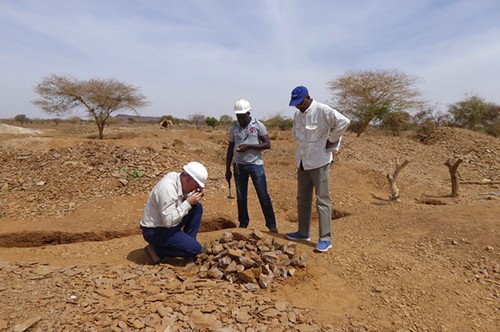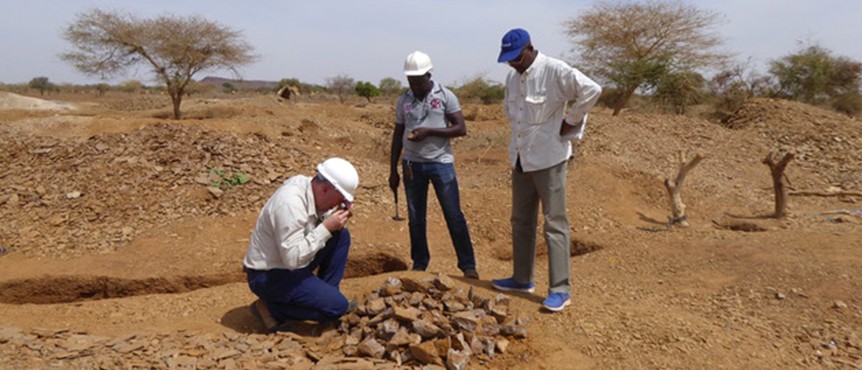International investors demonstrate reinvigorated appetite for Africa’s mining prospects – from traditional partners like the Australians to a growing Chinese and Russian presence.


Perth-based Golden Rim Resources is one of several Australian juniors flocking to the perspective gold fields of West Africa.
While miners may grumble about the consequences that cannabis wrought on investment funds for the junior sector in 2018, on the whole 2019 is shaping up to be a very good year for the industry. Commodity prices have demonstrated sustained recovery, and the 2018 World Economic Outlook (WEO) projects that global economic growth will remain strong for at least another year before decelerating. At the center of this growth is Africa, where real output growth increased from 3.6% in 2017 to 4.1% in 2018, a trend that is expected to continue into 2019. While diversification has been an important theme across the continent, the continent’s famed natural resources continue to drive foreign direct investment (FDI) and consequently economic performance.
Heightened geopolitical competition in Africa amongst traditional superpowers including Western Europe and the United States and newer investors like India and China is becoming increasingly visible. With China firmly cementing itself as the continent’s top trade partner, the world will be watching with particular interest to understand how the Sino-African relationship dynamic will evolve in coming years. China’s extraordinary volume of investments into the continent has irrevocably changed the trajectory of the mining industry; according to a study done by the German Institute of Global and Area Studies (GIGA), between 2005-2016 approximately half of China’s total outbound investments were in the energy and mining sectors of foreign countries, and about one third of this was dedicated to sub-Saharan Africa. In countries like the DRC, where over half of the country’s mines are now Chinese- owned, local and multinational service providers alike have been forced to adapt strategies to compete with their Chinese counterparts. Further Chinese investments outside of the mining sector in vital infrastructure-works have laid the groundwork for a scenario where China’s political and economic hegemony throughout the continent will be ubiquitous.
Russia has demonstrated a reinvigorated interest in the continent, and 2019 will see the first Africa-Russia summit. Russia will also play a role in the construction of a cross-continental railway line intended to connect East and West Africa, from Dakar to Dijibouti. While publicly it seems that the United States has toned down its interest in Africa, the numbers tell a different story. EY’s Africa Attractiveness report said that U.S. investors and business entities remain the continent’s largest FDI spenders, with a total of 130 projects in 2017, representing a 43% increase. In contrast, Asia-Pacific fell by 13%, and the ongoing trade wars between China in the United States could indirectly force China to reduce its imports from Africa as it manages a slowdown in its economy.
While Australia has been preoccupied by a more immediate need to strengthen its economic influence in the Asia-Pacific region, the country’s long tradition in mining and reputation for venturing abroad ensures a steady presence of Aussie investors in Africa, particularly in the exploration sector. “Modern exploration techniques such as airborne geophysics and gold processing technology were developed in Australia and subsequently brought to Africa. There were also many in the African diaspora that had left the continent for Australia and began go back to invest in the opportunities in their home-countries,” said Bill Witham, CEO, Australia-Africa Minerals and Energy Group (AAMEG). Witham noted that Australian involvement in Africa was spurred by the rising gold price in the 1980s when prospectors first ventured to countries like Zimbabwe and Zambia, in particular. He added, “In the 1990s, there was also a significant influx following the change of many governmental regimes that ushered in an era where state-owned companies and mining giants like AngloAmerican and Gold Fields no longer held a stranglehold over the industry.”
The United Kingdom will also bolster its presence in in Africa in 2019, a strategy punctuated by prime minister Theresa May’s visit to the continent in August 2018, the first from a sitting PM since 2013. Despite ongoing Brexit issues, the country intends to be a top G7 investor, will host an Africa investment summit in 2019, and plans to invest £50 million in support of diplomatic missions and the reopening of several embassies across the continent, according to Chatham House. Canada, as a global mining leader and home to roughly half of the world’s publicly listed mining and exploration companies, also remains important to Africa’s mining industry. However, 2016 saw the overall value of the country’s mining assets in Africa decline by 5.5%, suggesting a withdrawal of its presence.
African investors are also playing an increasing role in the development of their own countries, particularly as national governments strive to better provision for local content in mining legislation. Fears that this sort of thinking inevitably leads to resource nationalism are not unfounded, but they are perhaps exaggerated; the capital required for large-scale mining investments remains widely prohibitive for local investors, and international partners will continue to play an important role in extracting the continent’s natural resources for years to come. The delicate dance between government and international investors thus remains a fundamental theme of this publication, and with that in mind, in the next section we present some of the key issues considered among the investment community in contemplating a mining investment in Africa.

Perth-based Golden Rim Resources is one of several Australian juniors flocking to the perspective gold fields of West Africa.
While miners may grumble about the consequences that cannabis wrought on investment funds for the junior sector in 2018, on the whole 2019 is shaping up to be a very good year for the industry. Commodity prices have demonstrated sustained recovery, and the 2018 World Economic Outlook (WEO) projects that global economic growth will remain strong for at least another year before decelerating. At the center of this growth is Africa, where real output growth increased from 3.6% in 2017 to 4.1% in 2018, a trend that is expected to continue into 2019. While diversification has been an important theme across the continent, the continent’s famed natural resources continue to drive foreign direct investment (FDI) and consequently economic performance.
Heightened geopolitical competition in Africa amongst traditional superpowers including Western Europe and the United States and newer investors like India and China is becoming increasingly visible. With China firmly cementing itself as the continent’s top trade partner, the world will be watching with particular interest to understand how the Sino-African relationship dynamic will evolve in coming years. China’s extraordinary volume of investments into the continent has irrevocably changed the trajectory of the mining industry; according to a study done by the German Institute of Global and Area Studies (GIGA), between 2005-2016 approximately half of China’s total outbound investments were in the energy and mining sectors of foreign countries, and about one third of this was dedicated to sub-Saharan Africa. In countries like the DRC, where over half of the country’s mines are now Chinese- owned, local and multinational service providers alike have been forced to adapt strategies to compete with their Chinese counterparts. Further Chinese investments outside of the mining sector in vital infrastructure-works have laid the groundwork for a scenario where China’s political and economic hegemony throughout the continent will be ubiquitous.
Russia has demonstrated a reinvigorated interest in the continent, and 2019 will see the first Africa-Russia summit. Russia will also play a role in the construction of a cross-continental railway line intended to connect East and West Africa, from Dakar to Dijibouti. While publicly it seems that the United States has toned down its interest in Africa, the numbers tell a different story. EY’s Africa Attractiveness report said that U.S. investors and business entities remain the continent’s largest FDI spenders, with a total of 130 projects in 2017, representing a 43% increase. In contrast, Asia-Pacific fell by 13%, and the ongoing trade wars between China in the United States could indirectly force China to reduce its imports from Africa as it manages a slowdown in its economy.
While Australia has been preoccupied by a more immediate need to strengthen its economic influence in the Asia-Pacific region, the country’s long tradition in mining and reputation for venturing abroad ensures a steady presence of Aussie investors in Africa, particularly in the exploration sector. “Modern exploration techniques such as airborne geophysics and gold processing technology were developed in Australia and subsequently brought to Africa. There were also many in the African diaspora that had left the continent for Australia and began go back to invest in the opportunities in their home-countries,” said Bill Witham, CEO, Australia-Africa Minerals and Energy Group (AAMEG). Witham noted that Australian involvement in Africa was spurred by the rising gold price in the 1980s when prospectors first ventured to countries like Zimbabwe and Zambia, in particular. He added, “In the 1990s, there was also a significant influx following the change of many governmental regimes that ushered in an era where state-owned companies and mining giants like AngloAmerican and Gold Fields no longer held a stranglehold over the industry.”
The United Kingdom will also bolster its presence in in Africa in 2019, a strategy punctuated by prime minister Theresa May’s visit to the continent in August 2018, the first from a sitting PM since 2013. Despite ongoing Brexit issues, the country intends to be a top G7 investor, will host an Africa investment summit in 2019, and plans to invest £50 million in support of diplomatic missions and the reopening of several embassies across the continent, according to Chatham House. Canada, as a global mining leader and home to roughly half of the world’s publicly listed mining and exploration companies, also remains important to Africa’s mining industry. However, 2016 saw the overall value of the country’s mining assets in Africa decline by 5.5%, suggesting a withdrawal of its presence.
African investors are also playing an increasing role in the development of their own countries, particularly as national governments strive to better provision for local content in mining legislation. Fears that this sort of thinking inevitably leads to resource nationalism are not unfounded, but they are perhaps exaggerated; the capital required for large-scale mining investments remains widely prohibitive for local investors, and international partners will continue to play an important role in extracting the continent’s natural resources for years to come. The delicate dance between government and international investors thus remains a fundamental theme of this publication, and with that in mind, in the next section we present some of the key issues considered among the investment community in contemplating a mining investment in Africa.